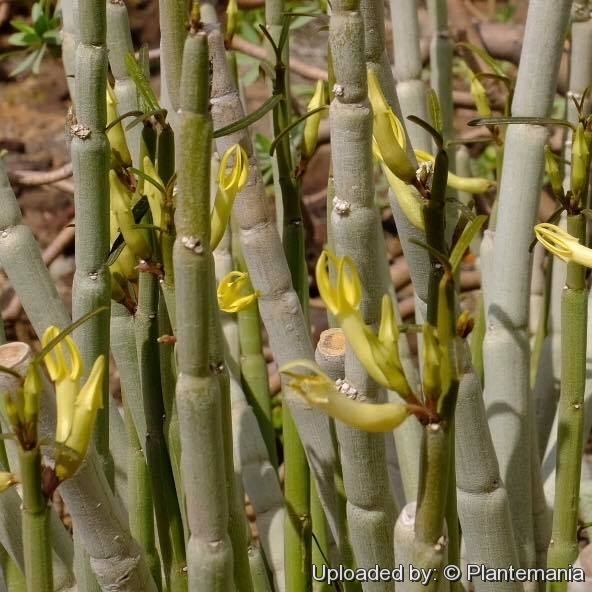
Ceropegia dichotoma Photo by: © Plantemania
Ceropegia dichotoma, blooming habit near Tenerife, Canary Islands, Spain, 14 February 2018.
Origin and Habitat: Ceropegia dichotomaSN|22135]]SN|22135]] is endemic to the Canary Islands archipelago. Tenerife (in the East: Anaga region, e.g. in the ridge above Faro de Anaga and on the West parts: Teno region, e.g. Barranco de los Cochinos), La Palma, La Gomera, Hierro, Lanzarote)
Habitat: This species occours abundantly in nature in the Tabaibal-Cardonal zone at up to about 600 m altitude where it forms large upright open shrubs. It is found preferably on white or cream-colored older grainy soils or rock crevices with good drainage, in sun exposed spots and prolonged dry climate
Synonyms:
See all synonyms of Ceropegia dichotoma
Common Names include:
SPANISH (Español): Cardoncillo
Description: Ceropegia dichotomaSN|32219]]SN|22135]] is the most succulent shrubby Ceropegia related to Ceropegia fuscaSN|11038]]SN|11038]] and probably to Ceropegia rupicolaSN|22135]]SN|32219]]. It starts as a single, firm, ascending stick, that in time makes a whole colony of basally branched succulent stems, covered with white wax under sunny conditions. Adult specimens look something like grey organ pipes.
Stems: Highly succulent, smooth with some constrictions which make them look like a row of small long sausages, 30-120 cm tall (but usually no higher than 60 centimetres and practically without leaves for most of the year), mainly erect, partly prostrate or decumbent. Terete 5-20 mm in diameter, green, olive-green or light-brown to whitish-green due to a wax layer.
Leaves: Sessile, linear-elliptic, 2-120 mm long, 3-8 mm wide slightly succulent, green, vein paler, mergins revolute. Leaves appear in the winter at each node and on the tip of the stem and are approx 5 cm long arranged in opposite pairs, they are deciduous and wilt quickly if there isn't enough water.
Flowers: The inflorescence is a terminal (sometimes in axillary) and almost sessile pseudo-umbels on upper stem section, bearing 1-15 florets (But usually 2 to 6). The individual flowers are lantern-shaped, yellow. Corolla 3-4 cm long, corolla tube 10-16 mm long, Corolla lobes, 5, yellow, narrowly triangular, fused to form a conical to ovoid cage, they are characteristically rolled outward, so that the windows are open wide. Pedicel 2-6 mm long, Sepals triangular 1-2 mm long acute.
Blooming season: Autumn and winter.
Fruits: The fruit is a pair of large horn-shaped capsules up to 12 cm long.
Subspecies, varieties, forms and cultivars of plants belonging to the Ceropegia dichotoma group
 Ceropegia dichotoma Haw.: has lantern-shaped, yellow flowers. Stems: green to olive-green. Distribution: Tenerife, La Palma, La Gomera, Hierro & Lanzarote.
Ceropegia dichotoma Haw.: has lantern-shaped, yellow flowers. Stems: green to olive-green. Distribution: Tenerife, La Palma, La Gomera, Hierro & Lanzarote. Ceropegia dichotoma subs. fusca (Bolle) G.D.Rowley: The lantern shaped flowers are dark reddish brown, the stems are glaucous-grey, reddish-green to olive green densely covered with white wax. Distribution: Tenerife, Gran Canaria and La Palma
Ceropegia dichotoma subs. fusca (Bolle) G.D.Rowley: The lantern shaped flowers are dark reddish brown, the stems are glaucous-grey, reddish-green to olive green densely covered with white wax. Distribution: Tenerife, Gran Canaria and La Palma- Ceropegia dichotoma subs. krainzii (Svent.) Bruyns
Bibliography: Major references and further lectures
1) Hermann Jacobsen “Abromeitiella to Euphorbia” Blandford Press, 1960
2) Hermann Jacobsen “A Handbook of Succulent Plants: Descriptions, Synonyms, and Cultural Details for Succulents Other Than Cactaceae”, Volume 1 Blandford Press, 1960
3) Focke Albers, Ulrich Meve “Illustrated Handbook of Succulent Plants: Asclepiadaceae” Volume 4 Springer, 2002
4) Per Sunding “The Vegetation of Gran Canaria” Univ.-Forlaget, 1972
5) “The Indoor Garden”, Volumes 23-26 Indoor Gardening Society of America, 1986
6) “Botanica: The Illustrated A-Z of Over 10,000 Garden Plants and how to Cultivate Them” Mynah, 1997
7) Werner Rauh “The Wonderful World of Succulents: Cultivation and Description of Selected Succulent Plants Other Than Cacti” Smithsonian Institution Press, 1984
8) James Cullen, Sabina G. Knees, H. Suzanne Cubey “The European Garden Flora Flowering Plants: A Manual for the Identification of Plants Cultivated in Europe, Both Out-of-Doors and Under Glass” Cambridge University Press, 11 August 2011
9) Wikipedia contributors. "Ceropegia dichotoma." Wikipedia, The Free Encyclopedia. Wikipedia, The Free Encyclopedia, 9 Dec. 2015. Web. 2 Jan. 2016.
10) Herbert F. J. Huber: “Revision of the genus Ceropegia”. In: Memórias da Sociedade Broteriana, Volume 12, 1957, S.1-203, Coimbra
11) Pérez, M. Á. C. “Native Flora of the Canary Islands”. Everest, León.1999.
12) Peter Schönfelder und Ingrid Schönfelder “Die Kosmos Kanarenflora”. 2. Aufl., 319 S., Franckh-Kosmos Verlags-GmbH & Co KG Stuttgart
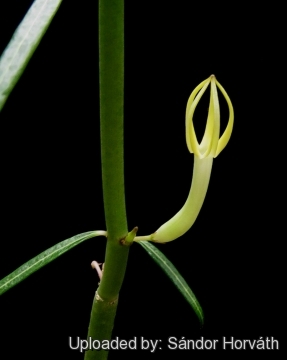 Ceropegia dichotoma Photo by: Sándor Horváth
Ceropegia dichotoma Photo by: Sándor Horváth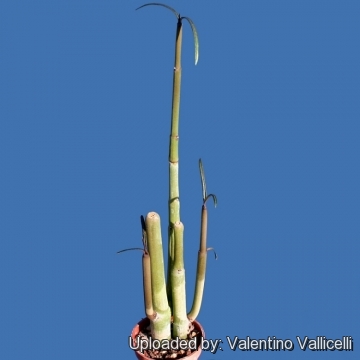 An interesting odd looking succulent, smooth with some constrictions which make it look like a row of small long sausages. Photo by: Valentino Vallicelli
An interesting odd looking succulent, smooth with some constrictions which make it look like a row of small long sausages. Photo by: Valentino Vallicelli Ceropegia dichotoma Photo by: Cactus Art
Ceropegia dichotoma Photo by: Cactus Art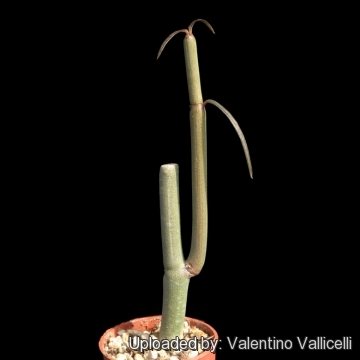 Ceropegia dichotoma Photo by: Valentino Vallicelli
Ceropegia dichotoma Photo by: Valentino Vallicelli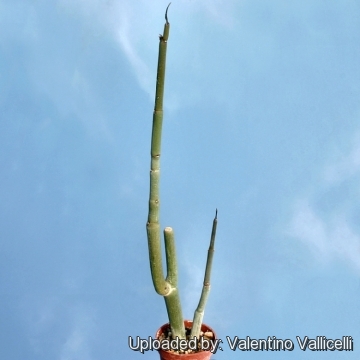 Ceropegia dichotoma Photo by: Valentino Vallicelli
Ceropegia dichotoma Photo by: Valentino Vallicelli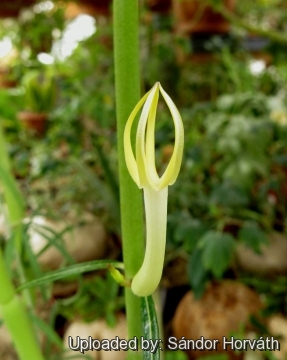 The strangely beautiful yellow flowers tip this odd species to the positive side. Photo by: Sándor Horváth
The strangely beautiful yellow flowers tip this odd species to the positive side. Photo by: Sándor Horváth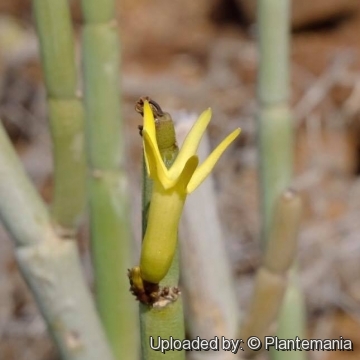 Ceropegia dichotoma, blooming habit near Tenerife, Canary Islands, Spain, 14 February 2018. Photo by: © Plantemania
Ceropegia dichotoma, blooming habit near Tenerife, Canary Islands, Spain, 14 February 2018. Photo by: © PlantemaniaSend a photo of this plant.The gallery now contains thousands of pictures, however it is possible to do even more. We are, of course, seeking photos of species not yet shown in the gallery but not only that, we are also looking for better pictures than those already present.
Read More... Cultivation and Propagation: Full to part sun, moderate water in warm season, drier in winter. It requires hot conditions and how much sun as possible to grow well. Can be grown outdoor in mild climate where it proves to grow well semi-neglected. It is also very resistant and is very rare to see an aphid or a sick part, be only aware of mealy bugs.


















